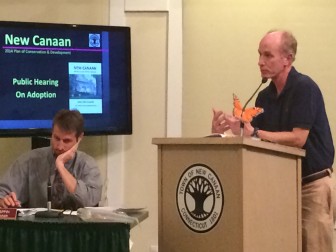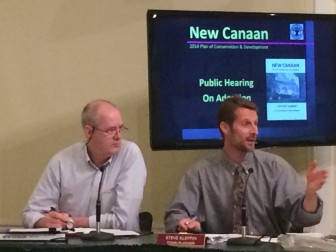Though he lives just 400 feet from the heart of downtown New Canaan, Mark Noonan of St. John’s Place said he rarely walks into the heart of our village.
Based on his own experience, Noonan said during a Planning and Zoning Commission meeting Tuesday night that it’s a mistake to think erecting multi-level residential buildings in areas such as nearby Grove Street—for older town residents seeking smaller housing in town, say—would lead to those same people walking into town.
While Noonan praised the focus of a proposed Plan of Conservation and Development or “POCD” on areas such as downtown parking and preserving our village’s character, he added, “The height is such a sensitive issue.”

Mark Noonan speaks at the June 3 meeting of the Planning & Zoning Commission. Credit: Michael Dinan
“Opening the door at all to height changes I think is really harmful to the town because it encourages greater density, greater packing and there’s always losers and winners when height restrictions change,” Noonan said during a final public hearing on the POCD, held in the Sturgess Room of the New Canaan Nature Center’s Visitors Center. “And certainly it can dramatically change the town character.”
The updated POCD—an advisory, state-mandated planning document designed to guide generally the future of development in the community (as opposed to a set of regulations that determine what must or must not happen)—has been in development since last year. P&Z now is making final edits to the two major pieces of the POCD: One outlines the principles (in some instances, in detail and with case studies) that will guide development, and the other with prioritized steps designed to achieve the first part’s overall vision.
P&Z and the town planner have held information sessions on the POCD for at least one year and public hearings for many months. With a small turnout Tuesday night, P&Z Secretary Jean Grzelecki said the group would wait until a July meeting to approve the plan formally.

L-R: Glenn Chalder of Avon-based Planimetrics and Town Planner Steve Kleppin at the June 3, 2014 meeting of the Planning & Zoning Commission. Credit: Michael Dinan
Glenn Chalder of Avon-based Planimetrics—a multidisciplinary firm that’s assisted with the creation of some 20 POCDs, including in Greenwich and Wilton—is helping here, too.
The value and purpose of the planning process, Chalder said, “is not to let things happen by chance, to actually set down some principles and guidelines of how we’d like to think about approaching the future to make New Canaan an even better place.”
One major consideration is the way that New Canaan is aging. Over the next decade or two, Chalder said, New Canaan will be older—that is, its median age will be higher—than it ever has been before.
“So our needs as a community are likely to be different than they’ve been in the past, and these are some of the issues that the plan looks at and suggests we address,” he said.
The overall philosophy of the POCD is this: “Promote an appropriate balance of conservation and development in order to enhance community character and improve the overall quality of life.” The POCD outlines that effort in four major areas of the “Strategic” part of the plan (one recent draft of the full plan can be found here, it’s widely recommended reading). Here we list each of those four and include a snippet from Chalder at the meeting:
- Preserve and Enhance Community Character (protect physical character, preserve and enhance open space, preserve historic resources and promote community involvement): “The concept of preserving and enhancing the community character, really, over the time that I’ve had a chance to work in New Canaan, has been the leading issue, the issue at the top of everybody’s agenda.”
- Nurture Downtown (maintain and enhance the character of downtown, “rationalize” parking, guide development and redevelopment, support downtown, address other downtown issues): “Guiding the development of the downtown area to ensure that it remains the special place that it is. In the palette of downtowns in the state of Connecticut, New Canaan’s is unique. I think preserving and enhancing its character in the future is important, and there are going to be development activities guiding them. It’s an important strategy in the plan.”
- Enhance Livability (provide appropriate facilities and services, protect residential neighborhoods, provide for a diverse housing portfolio, enhance the walking environment, bicycle circulation, wireless communications and energy services): “The plan talks about continuing our community facilities and services and making those the best that we can. Protecting residential neighborhoods, both because most of New Canaan is residentially zones, this is where people live, but also addresses some of the issues the community and commission have faced in terms of institutional uses in residential zones, and recommend strategies to address that in the future. The plan recommends diversifying our housing portfolio to address the changing housing needs. As people age, their housing needs change as well, they might desire a different configuration of houses. Either smaller houses or master bedrooms on the first floor or other situations that their current houses may not have. So if our age composition is going to change in the future, then we should think about ways that New Canaan can always be home.”
- Achieve Sustainability and Resliency (maintain environmental health, promote sustainability and resiliency): “The natural resources in New Canaan contribute to our sense of character, our openness in the community and the character we love so much, maintaining environmental health is important to the residents. Promoting sustainability in terms of wise use of resources-water, energy and so on.”
The POCD in the downtown section, characterizes “Promote Appropriate Development” in terms of an evolution that includes housing, offices, retail and restaurants and entertainment, cultural and municipal facilities.
“The most appropriate types of development for the downtown area will be appropriately scaled and designed to fit into the existing fabric of the downtown area,” the fifth draft of the POCD says. “Building design and scale is especially important … Multi-story, moderate density, mixed-use development (generally with residential and/or office use on upper floors combined with retail shops or other active uses at street level) would reflect the pattern of much of the existing development in the downtown.”
Parts of the “Implementation” section of the POCD will look familiar to New Canaanites who follow local news, for example:
- “Continue to encourage ‘sensitive ownership’ where people who love historic buildings own them and maintain them.”
- “Continue to sponsor and promote activities that enhance the overall sense of community spirit and pride.”
- “Identify a solution to garbage and litter issues in the downtown.”
- “Work with delivery companies and businesses to establish specific loading zones (and defined hours, if necessary) for delivery trucks and enforce them.”
- “Support efforts by the New Canaan Housing Authority to renovate and expand the number of units on Millport Avenue.”
- “Continue to expand the sidewalk network, either as part of road paving projects or as independent sidewalk installations.”
- “Enhance wireless coverage in New Canaan.”
- “As opportunities present themselves, seek to establish mid-block links in the pedestrian circulation system.”
In many cases, the plan aims to arm planning officials with powers and tools they don’t have now to gain more control over development—for example in “institutional uses” of properties in residential zones (YMCA, St. Luke’s, churches).
One public commenter at the meeting, Haik Kavookjian, read a letter from Soundview Lane residents Kathleen and Joe Sweeney, who support the POCD as it seeks to address concerns about “institutional use.”
“We believe the tough, statutory safeguards for definitions for appropriate structure heights, setbacks, screens, lights, hardened density and coverage, as well as traffic patterns, are necessary to prevent encroachment of special nonresidential entities such as St. Luke’s to purchase adjacent properties to expand or modify their institutional or commercial footprint,” the Sweeneys said in their letter. “Each of us as residents in the town has the opportunity to leave the town better than we found it. One route in achieving this, in our opinion, is by implementing and adhering to the guidelines proposed by Planimetrics.”
Most speakers had wide praise for the commission and Town Planner Steve Kleppin.
New Canaan resident and landscape architect Keith Simpson complimented P&Z on its steady inclusiveness of the public in developing the plan.
“I really can’t at this point if there is any major element which hasn’t been brought up, looked at or in some way or another worked into the plan,” he said. “So I think at this stage it’s really an outstanding document.”
Janet Lindstrom, a town resident who serves as director of the New Canaan Historical Society and chair of the Historic District Commission, noted the attention paid to mid-century modern homes in New Canaan.
“I think the plan has done a really good job of understanding the town of New Canaan,” Lindstrom said.